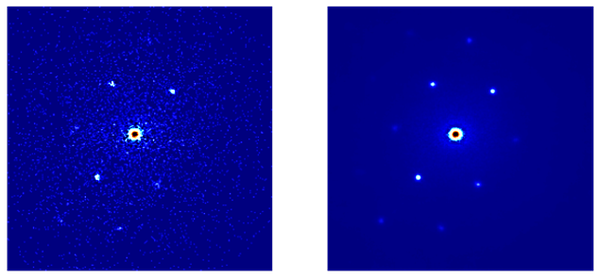Unsupervised Machine Learning-Based STEM Diffraction Pattern Denoising for Enhanced Grain Visualization in Phase Change Materials

Phase change materials (PCM) are an emerging class of materials in which different phases of the same material may have different optical, electric, or magnetic properties and can be used as a phase change memory. Phase-change memory materials, exemplified by (Ag, In)-doped Sb2Te (AIST) in this research, have several advantages, including high-speed read and write operations, non-volatility, and a long lifespan. PCMs are able to switch between amorphous and crystalline phases when subjected to heat or electrical current. However, the full understanding of PCMs depends heavily on accurate characterization, often through techniques like scanning transmission electron microscopy (STEM).
In the field of materials science and nanotechnology, the analysis of STEM diffraction patterns is crucial for understanding the structural characteristics of materials, especially in the context of PCMs. Accurate interpretation of diffraction patterns is essential for crystallographic analysis, phase identification, and grain visualization in PCMs during the in-situ switching experiment. However, the analysis of STEM diffraction patterns in PCMs can be challenging due to the presence of noise and weak signals.

In this study, we present a solution to address this challenge. We propose an unsupervised machine learning (ML) approach that employs an autoencoder to denoise STEM diffraction patterns. Autoencoders are neural network architectures known for their ability to learn and represent complex data in a lower-dimensional, noise-reduced form. By applying this technique, we enhance the quality of diffraction patterns, improving the signal-to-noise ratio.
Our results demonstrate a significant enhancement in the clustering and visualization of crystalline grains within STEM diffraction patterns of phase change materials. By reducing noise and enhancing signal clarity, the unsupervised ML-based denoising technique allows for more precise discrimination between different crystallographic orientations and refines the identification of grain boundaries. The proposed approach paves the way for a deeper understanding of phase change behavior, aiding in designing and optimizing PCMs for various applications, from thermal energy storage to non-volatile memory technology.
The proposed denoising technique is not limited to PCM. It does not require the laborious production of specific training data and, therefore, can serve as a universal tool for STEM diffraction pattern denoising and signal enhancement.
Related Publications:
- K. Ruzaeva, D. Weber, J. Werner, S. Sandfeld, "Unsupervised Machine Learning-based STEM diffraction pattern denoising for enhanced grain visualization in phase change materials", BIO Web Conf., 129 (2024) 10022, doi: https://doi.org/10.1051/bioconf/202412910022
Contact:
Dr. Karina Ruzaeva
Tel.: +49 241/927803-40
E-mail: k.ruzaeva@fz-juelich.de
